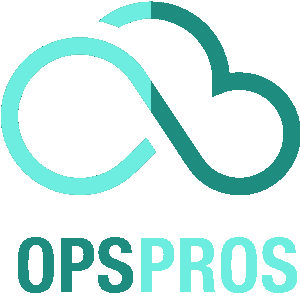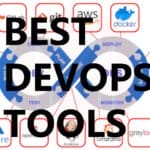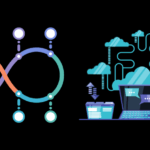Today, our focus will be on unraveling what data sources are typically used to train AI models for predicting resource demand in DevOps.

DevOps and AI
Artificial Intelligence (AI) and DevOps are two terms we will frequently encounter in this discussion. AI refers to the simulation of human intelligence in machines that are programmed to think like humans and mimic their actions.
DevOps, a blend of ‘Development’ and ‘Operations’, fosters enhanced collaboration between the programmers who craft software and the operations personnel who maintain it.
AI (Artificial Intelligence) involves imbuing machines with human-like intelligence, enabling them to learn, reason, and improve over time.
AIOps (Artificial Intelligence for IT Operations) arises from the convergence of AI and DevOps, leveraging machine learning and data science to streamline and expedite IT operations. A vital component of AIOps is predicting resource demand, a crucial aspect of resource management in DevOps.
AI thrives on data. It is the lifeblood that propels AI, enabling them to learn, adapt, and make accurate predictions. To illustrate, we can compare an AI model to a child learning from their experiences.
The more varied and diverse the experiences (data), the better the child’s (AI model’s) ability to understand and predict patterns.
In DevOps, data-driven AI models have emerged as an indispensable tool for predicting resource demand, facilitating optimal utilization, and minimizing waste. But what types of data are we referring to?
Let’s delve into the specific data sources that are typically used to train these AI models.
Role of Data in AI Models
Data serves as the lifeblood of AI models. In DevOps, AI models use data to discern patterns, learn from these patterns, and make accurate predictions about resource demand. These models train on diverse data sets, allowing them to project future outcomes based on historical and current data patterns.
Historical Data

Historical data is invaluable for predicting resource demand. This data, encompassing past patterns of resource usage like CPU utilization, memory usage, and disk space needs, forms the foundational knowledge base for AI models.
By analyzing this data, AI models can spot trends and forecast future resource demand.
Historical data refers to the archive of past events or metrics, usually stored in databases or data lakes. This type of data serves as an essential input to AI models in predicting resource demand in DevOps.
In DevOps, historical data might include past patterns of resource usage such as CPU utilization, memory usage, and disk space needs. Analyzing this data allows the AI models to identify trends and extrapolate these to forecast future resource requirements.
A simple Python code illustrating how you might load historical data and train a model would be:
import pandas as pd
from sklearn.ensemble import RandomForestRegressor
# Load historical data
historical_data = pd.read_csv('historical_data.csv')
# Separate features and target
X_train = historical_data.drop('target', axis=1)
y_train = historical_data['target']
# Initialize and train the model
model = RandomForestRegressor()
model.fit(X_train, y_train)In this script, we first import the necessary libraries and then load our historical data from a CSV file. The features and target variables are separated, and a Random Forest Regressor model is trained on this data.
Pro Tip: Keep historical data clean and updated for better model performance.
Key Takeaways
- Historical data is an archive of past events or metrics.
- It can include past patterns of resource usage.
- This data can help AI models identify trends and predict future resource needs.
Wrapping Up
To sum it up, historical data serves as a valuable input for AI models predicting resource demand in DevOps. By capturing and analyzing past resource utilization patterns, these models can make informed predictions about future demand, thereby ensuring optimal resource allocation.
Log Files

In the landscape of DevOps, log files function as essential chronicles of software development and deployment processes. These files record events as they occur over time, tracking everything from user activity to system performance, and are vital for debugging, analysis, and now, AI-based resource demand prediction.
Consider log files as the “black box” of your DevOps processes. They keep a tab on resource consumption during different stages of the software development lifecycle, highlighting potential bottlenecks and performance hits.
To better illustrate, consider a simple scenario where you parse a log file to extract data on memory usage:
import pandas as pd
# Parse log file
log_data = pd.read_csv('logfile.log', sep=" ", header=None)
# Extract memory usage data
memory_usage = log_data[log_data[1]=='MEMORY_USAGE']
# Analyze or pass memory_usage data to your AI modelIn this Python script, we’re parsing a log file, filtering out memory usage entries, and then either analyzing this data or using it to train our AI model.
Pro Tip: Regular and efficient log file analysis can proactively identify potential resource bottlenecks.
Key Takeaways
- Log files are records of software development and deployment processes.
- They can provide insights into resource consumption and help identify potential bottlenecks.
- The extracted data can be used to train AI models for resource demand prediction.
Wrapping Up
Log files, with their wealth of operational data, offer valuable insights into resource consumption patterns. These insights, when harnessed by AI models, can significantly enhance the accuracy of resource demand prediction.
Transaction Data

Transaction data is another crucial source of information when it comes to training AI models in DevOps. Derived from databases or data lakes, this data consists of records of all transactions executed within the system.
In the context of DevOps, transaction data can encompass records of user interactions, system events, or changes in resource states.
Such data provides a detailed insight into resource usage patterns and the factors influencing these patterns. By analyzing transaction data, AI models can foresee future resource demand by correlating past transaction patterns with corresponding resource needs.
Here’s a simple example of how you might pull transaction data from a SQL database and pass it to your model:
import pandas as pd
import sqlite3
# Create a DB connection
conn = sqlite3.connect('transaction_data.db')
# Query to fetch transaction data
query = 'SELECT * FROM transactions'
# Execute the query and store the result in a DataFrame
transaction_data = pd.read_sql_query(query, conn)
# Pass the transaction_data to your AI modelIn this Python code, we’re connecting to a SQLite database, fetching transaction data using a SQL query, and storing the result in a DataFrame, which can then be passed to the AI model.
Pro Tip: Regularly update your transaction data to ensure your AI model learns from the most recent patterns.
Key Takeaways
- Transaction data consists of records of all transactions within the system.
- This data can provide detailed insights into resource usage patterns.
- Analyzing transaction data can help AI models predict future resource demand.
Wrapping Up
In essence, transaction data presents a treasure trove of insights for AI models predicting resource demand in DevOps. By correlating past transaction patterns with resource usage, these models can accurately anticipate future demand, optimizing resource allocation.
Real-Time Monitoring Data

Real-time monitoring data is a game-changer in the world of DevOps. This data originates from ongoing surveillance of your infrastructure and applications, providing timely updates on their performance and resource usage.
Real-time monitoring data can include CPU utilization, memory usage, network bandwidth, database performance, and more.
AI models can leverage this constant stream of information to discern resource usage patterns on the fly and dynamically adjust resource allocation as per demand. Moreover, real-time data can alert these models to sudden spikes or drops in resource demand, allowing for quick remedial actions.
Here’s a simple Python script showing how you might obtain real-time data using a hypothetical monitoring API and use this data for your AI model:
import requests
import json
# Fetch real-time monitoring data from the API
response = requests.get('http://monitoringapi.example.com')
# Convert the response to a JSON object
monitoring_data = response.json()
# Pass the monitoring_data to your AI modelIn this script, we’re using the requests library to send a GET request to a monitoring API, convert the response to a JSON object, and pass this data to the AI model.
Pro Tip: Implement robust real-time monitoring to maintain a pulse on your resources and their usage.
Key Takeaways
- Real-time monitoring data provides current updates on infrastructure and application performance.
- It can be used by AI models to identify resource usage patterns dynamically.
- Real-time data helps AI models adjust resource allocation as per the current demand and respond swiftly to any sudden changes.
Wrapping Up – what data sources are typically used to train AI models for predicting resource demand in DevOps
Real-time monitoring data empowers AI models to react dynamically to changes in resource demand, optimizing resource allocation in DevOps.
External Data Sources
While historical data, log files, transaction data, and real-time monitoring data all provide insights from within the organization, external factors can also significantly impact resource demand. These external factors, tracked through various external data sources, might include market trends, customer behavior, and seasonal patterns.
In the context of DevOps, if your applications cater to end-users, factors such as user activity peaks, holiday seasons, or even social events can drive sudden spikes in resource usage.
Therefore, incorporating these external data sources into your AI models can help them better anticipate these spikes and adjust resource allocation proactively.
For instance, if you’re pulling customer activity data from an external API, your Python script might look like this:
import requests
import json
# Fetch customer activity data from the API
response = requests.get('http://customeractivityapi.example.com')
# Convert the response to a JSON object
customer_activity_data = response.json()
# Pass the customer_activity_data to your AI modelThis script sends a GET request to a hypothetical customer activity API, processes the response into a JSON object, and passes this data to the AI model.
Pro Tip: Don’t overlook external factors. Incorporating them into your AI model can significantly enhance the accuracy of resource demand prediction.
Key Takeaways
- External data sources track factors outside the organization that can impact resource demand.
- These factors might include market trends, customer behavior, and seasonal patterns.
- Incorporating external data sources into AI models can help predict sudden spikes in resource demand.
Wrapping Up
While internal data sources offer invaluable insights into resource usage patterns, external factors can play a crucial role in influencing resource demand. By incorporating external data sources into AI models, we can better anticipate these influences, improving the accuracy of resource demand prediction.
Challenges and Limitations

While leveraging data sources for training AI models in DevOps can yield significant benefits, it’s also essential to acknowledge the challenges and limitations that come with it.
Data Quality: A model is only as good as the data it’s trained on. Poor quality data, characterized by inaccuracies, inconsistencies, or incompleteness, can lead to inaccurate predictions. It’s crucial to have robust data cleaning and preprocessing strategies in place.
Privacy Issues: When dealing with data, especially external data or user-related transaction data, privacy concerns come into play. Organizations must ensure they adhere to data privacy laws and regulations.
Data Integration: Bringing together different types of data, from various sources, both internal and external, can be a complex process. It requires effective data management and integration strategies.
Pro Tip: Always ensure the data you’re using is of high quality, respects privacy regulations, and is well-integrated for optimal use by the AI model.
Key Takeaways
- Data quality, privacy issues, and data integration are significant challenges in using data to train AI models.
- Robust strategies for data cleaning, privacy adherence, and data management can help overcome these challenges.
Case Studies or Practical Examples – what data sources are typically used to train AI models for predicting resource demand in DevOps

I understand the importance of real-world examples to illustrate how data sources are typically used to train AI models for predicting resource demand in DevOps. These case studies highlight the practical application of AI in resource management and provide valuable insights into the effectiveness of different data sources.
Netflix: Optimizing Resource Allocation Through AI
One prominent example comes from the streaming giant, Netflix. By harnessing the power of AI, Netflix leverages historical data, real-time streaming data, and user behavior data to predict resource demand accurately.
The AI models analyze historical usage patterns, monitor real-time streaming data, and consider factors like user activity peaks and seasonal trends.
This comprehensive analysis enables Netflix to optimize resource allocation, ensuring a seamless streaming experience for millions of users worldwide.
import pandas as pd
from sklearn.ensemble import RandomForestRegressor
# Load historical usage data
historical_data = pd.read_csv('historical_data.csv')
# Separate features and target
X_train = historical_data.drop('target', axis=1)
y_train = historical_data['target']
# Initialize and train the model
model = RandomForestRegressor()
model.fit(X_train, y_train)
In this code snippet, Netflix loads historical usage data, separates features and target variables, and trains a Random Forest Regressor model. This model learns from the historical data to predict future resource demand accurately.
Pro Tip: Continuously update historical usage data to ensure your AI model adapts to changing trends and patterns.
Etsy: Forecasting Resource Demand through Transaction Data
Another notable example comes from Etsy, the popular online marketplace. Etsy utilizes AI-driven predictive analytics to forecast resource demand effectively. By analyzing transaction data and user behavior data, Etsy gains insights into customer activity patterns, trends, and product popularity.
This analysis enables Etsy to anticipate resource demand spikes and make informed infrastructure decisions.
import pandas as pd
from sklearn.linear_model import LinearRegression
# Load transaction data
transaction_data = pd.read_csv('transaction_data.csv')
# Separate features and target
X_train = transaction_data.drop('target', axis=1)
y_train = transaction_data['target']
# Initialize and train the model
model = LinearRegression()
model.fit(X_train, y_train)In the above code snippet, Etsy loads transaction data, separates features and target variables, and trains a Linear Regression model. This model uses transaction data to predict future resource demand accurately.
Pro Tip: Regularly update transaction data to capture evolving customer behavior and market trends.
Key Takeaways
- Netflix and Etsy serve as excellent case studies showcasing the practical application of AI in predicting resource demand.
- Historical usage data, real-time streaming data, and user behavior data play a significant role in optimizing resource allocation.
- Transaction data and user behavior data enable accurate forecasting of resource demand.
Wrapping Up
These case studies demonstrate the power of AI models in predicting resource demand within DevOps. By leveraging diverse data sources and employing sophisticated algorithms, organizations like Netflix and Etsy have achieved efficient resource allocation and improved operational efficiency.
Through historical data, real-time monitoring, transaction data, and external data sources, AI models are capable of accurately predicting resource demand, enabling organizations to allocate resources effectively and deliver exceptional user experiences.
Future Trends in AI and DevOps – what data sources are typically used to train AI models for predicting resource demand in DevOps
As we look forward, we can anticipate continued evolution and innovation in how AI is used within DevOps, especially concerning resource demand prediction.
More Data Sources: As technology advances, new types of data will become available, such as more detailed real-time data or enhanced external data sources, further improving prediction accuracy.
Improved Models: As AI and Machine Learning continue to evolve, we can expect models to become more sophisticated, making better use of the data and providing more accurate predictions.
Pro Tip: Stay informed about emerging trends and developments in AI and DevOps. This field is rapidly evolving, and staying up-to-date will help you make the most of your resource demand prediction models.
Key Takeaways
- The future will see more diverse data sources and improved AI models.
- Staying current with these trends can help you leverage AI most effectively in DevOps.
Benefits of Predicting Resource Demand
Predicting resource demand in DevOps through AI models trained on diverse data sources brings numerous benefits. In this section, we’ll explore the advantages of accurately forecasting resource requirements and how it optimizes resource allocation and improves overall efficiency.
Resource demand prediction is the process of estimating the quantity of resources, such as CPU, memory, and network bandwidth, needed to support an application or process.
By training AI models on various data sources, including historical data, log files, transaction data, real-time monitoring data, and external factors, organizations can gain valuable insights that lead to more informed resource allocation decisions.
Efficient Resource Allocation
One of the key benefits of predicting resource demand is efficient resource allocation. With accurate predictions, DevOps teams can allocate resources optimally.
As a result, each component has the necessary resources to operate smoothly without unnecessary over-provisioning or underutilization. Moreover, by dynamically scaling resources based on the predicted demand, teams can ensure efficient allocation.
Minimizing Waste
Accurate resource demand prediction helps minimize waste. By precisely anticipating demand, organizations can strike the right balance, avoiding wasteful excess and ensuring resources are utilized optimally.
This approach prevents over-provisioning, which can lead to unnecessary costs, as well as under-provisioning, which can cause performance issues. The ability to allocate resources according to actual demand minimizes waste and promotes cost-effectiveness.
Improved Efficiency
Predicting resource demand in DevOps leads to improved overall efficiency in software development and deployment processes.
By accurately allocating resources based on predictions, teams can meet performance requirements, deliver software on time, and avoid bottlenecks or performance degradation caused by resource limitations.
This efficient allocation ensures that resources are available when needed, optimizing the efficiency of the entire development and deployment pipeline.
Pro Tip:
To optimize the benefits of predicting resource demand, regularly monitor and update your AI models based on new data patterns and changes in the system. Embrace a culture of continuous improvement and refinement to ensure the accuracy and effectiveness of your predictions.
Key Takeaways
- Predicting resource demand optimizes resource allocation and avoids over-provisioning or underutilization.
- Accurate predictions minimize waste, leading to cost savings.
- Improved efficiency in software development and deployment processes is achieved through better resource allocation.
Wrapping Up – what data sources are typically used to train AI models for predicting resource demand in DevOps
Predicting resource demand in DevOps using AI models trained on diverse data sources provides numerous benefits. It enables efficient resource allocation, minimizes waste, and improves overall efficiency.
By leveraging the power of AI and analyzing the right data, organizations can achieve better resource management, ensuring smooth operations and optimized software delivery. Remember, accurate predictions pave the way for a successful DevOps journey.
By using a variety of data sources, AI models can predict resource demand with increased accuracy, leading to optimized DevOps practices.
Despite some challenges, the promise of ongoing advancements in AI and a growing diversity of data sources makes the future look bright for resource management in DevOps. The key lies in staying informed, adaptable, and constantly striving for improvement in this rapidly evolving field.

Noah is an accomplished technical author specializing in Operations and DevOps, driven by a passion ignited during his tenure at eBay in 2000. With over two decades of experience, Noah shares his transformative knowledge and insights with the community.
Residing in a charming London townhouse, he finds inspiration in the vibrant energy of the city. From his cozy writing den, overlooking bustling streets, Noah immerses himself in the evolving landscape of software development, operations, and technology. Noah’s impressive professional journey includes key roles at IBM and Microsoft, enriching his understanding of software development and operations.
Driven by insatiable curiosity, Noah stays at the forefront of technological advancements, exploring emerging trends in Operations and DevOps. Through engaging publications, he empowers professionals to navigate the complexities of development operations with confidence.
With experience, passion, and a commitment to excellence, Noah is a trusted voice in the Operations and DevOps community. Dedicated to unlocking the potential of this dynamic field, he inspires others to embrace its transformative power.






